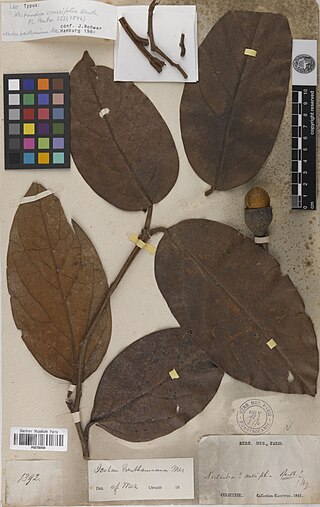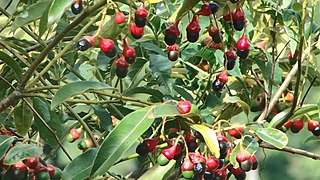
Lauraceae, or the laurels, is a plant family that includes the true laurel and its closest relatives. This family comprises about 2850 known species in about 45 genera worldwide. They are dicotyledons, and occur mainly in warm temperate and tropical regions, especially Southeast Asia and South America. Many are aromatic evergreen trees or shrubs, but some, such as Sassafras, are deciduous, or include both deciduous and evergreen trees and shrubs, especially in tropical and temperate climates. The genus Cassytha is unique in the Lauraceae in that its members are parasitic vines. Most laurels are highly poisonous.

Ocotea is a genus of flowering plants belonging to the family Lauraceae. Many are evergreen trees with lauroid leaves.

Ocotea bullata, is a species of flowering tree native to South Africa. It produces very fine and valuable timber which was formerly much sought after to make furniture. Due to over-exploitation it is now a protected species. Other names for it are Cape Walnut, Cape laurel, and laurel wood. The name "stinkwood" comes from a strong smell that is released when it is fresh felled.
Kuloa usambarensis is a species of tree in the laurel family (Lauraceae). It is native to eastern Africa in Kenya, Tanga Region of Tanzania, and locally in Uganda, where it occurs at 1600–2600 m elevation in high rainfall Afromontane cloud forest. Common names include East African camphorwood, mkulo (Tanzania), mwiha (Uganda), muwong, muzaiti, and maasi.

Ocotea aciphylla is a species of Ocotea in the plant family Lauraceae. It forms a tree 12–18 m tall. It has small hermaphrodite flowers of 3–4 mm long. It is found in the Amazon river basin mostly to 1200 m.

Ocotea basicordatifolia is a species of Ocotea in the plant family Lauraceae.

Ocotea benthamiana is a species of Ocotea in the plant family Lauraceae. It is an evergreen tree to 25–35 m tall. Its conservation status is classed as vulnerable.

Ocotea catharinensis is a member of the plant family Lauraceae. It is a slow-growing evergreen, a valuable hardwood tree of broad ecological importance, and it is threatened by habitat loss and by overexploitation for its timber and essential oils.

Ocotea cymbarum is a species of Ocotea in the plant family Lauraceae. It is an evergreen tree found in Brazil, Colombia, French Guiana, Guyana, Suriname, and Venezuela.

Ocotea foetens, commonly called til or stinkwood is a species of tree in the family Lauraceae. It is evergreen and grows up to 40 m tall. It is a common constituent of the laurisilva forests of Madeira and the Canary Islands. Leaf fossils of this species are known from the Mio-Pleistocene of Madeira Island.

Ocotea porosa, commonly called imbuia or Brazilian walnut, is a species of plant in the Lauraceae family. Its wood is very hard, and it is a major commercial timber species in Brazil.

Ocotea odorifera is a species of plant in the family Lauraceae. It is an evergreen tree in the genus Ocotea.

Ocotea puberula is a species of evergreen tree in the plant genus Ocotea of the family Lauraceae. It is found in Argentina, Brazil, French Guiana, Guyana, Mexico, Peru, and Suriname.
Ocotea rotundata is a species of evergreen tree in the genus of plants Ocotea, in the family Lauraceae. It is endemic to Ecuador. Its natural habitat is subtropical or tropical moist montane forests.
Ocotea rugosa is a species of evergreen tree to 10 m (33 ft) tall in the plant genus Ocotea, in the family Lauraceae. It is endemic to Andean Ecuador at an altitude of 1,700 to 2,500 m. Its natural habitat is subtropical or tropical moist montane forests and cloud forest. This species requires moisture and protection of other trees for growing. The principal threats are fires, grazing, and the conversion of forest to farmland.
Platypterocarpus tanganyikensis is a species of flowering plant in the family Celastraceae. It is a tree endemic endemic to the West Usambara Mountains of Tanzania, where it grows 13 to 27 meters tall. It is the sole species in genus Platypterocarpus.
Neocussonia lukwangulensis is a species of plant in the family Araliaceae. It is endemic to the Eastern Arc Mountains of Tanzania. It is typically a freestanding tree, and uncommonly an epiphyte.
Maytenus umbellata is a species of plant in the family Celastraceae. Common names include Buxo-da-rocha and Madeira shrubby bittersweet. It is endemic to Madeira.
Samuelssonia is a monotypic genus of flowering plants belonging to the family Acanthaceae. It has only one known species, Samuelssonia verrucosa, a small tree which grows to 5 meters tall which is native to the Massif de la Hotte in Haiti.
Kuloa michelsonii is a species of tree in the laurel family (Lauraceae). It is native to Rwanda and the eastern Democratic Republic of the Congo.












